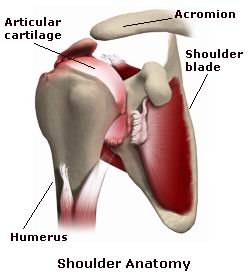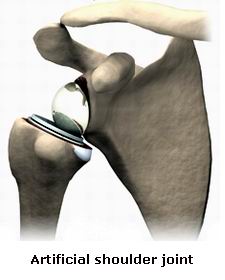Osteoarthritis, is the most common reason why a doctor would recommend a person to undergo a shoulder replacement surgery. Osteoarthritis though uncommon for shoulder joint, is caused by the degeneration of the joint over time through wear and tear which can be caused by ageing. Often, osteoarthritis can occur years after an injury to the shoulder. Damage is caused to the articular cartilage and other joint tissues by the extra movement or repeated dislocation of the unstable joint. Over time, this damage leads to osteoarthritis. Systemic diseases, such as rheumatoid arthritis, may affect any joint in the body. Whatever the type or cause of the arthritis, the shoulder may become painful and difficult to use. If this pain cannot be controlled or if it becomes impossible to use your shoulder for daily tasks, your doctor may recommend shoulder replacement surgery.
The Shoulder joint

There are two major types of artificial shoulder replacements: a cemented prosthesis and an un-cemented prosthesis. A cemented prosthesis is held in place by a type of epoxy cement that attaches the metal to the bone. An un-cemented prosthesis has a fine mesh of holes on the surface where the bone grows into the mesh. Over time, this anchors the prosthesis to the bone.
The surgeon determines the type of replacement joint based on your age, your lifestyle, and the surgeon's experience.
The prosthesis is made up of two parts, the humeral component replaces the humeral head, or the ball of the joint and the glenoid component replaces the socket of the shoulder, which is actually part of the scapula.
The humeral component is made of metal. The glenoid component is usually made of two parts. A metal tray attaches directly to the bone and a plastic cup forms the socket. The plastic is very tough and very slick, very much like the articular cartilage that it would be replacing.

Shoulder replacement surgery is done through an incision on the front of your shoulder. This is called Artificial Shoulder Jointan anterior approach. The surgeon cuts through the skin and then isolates the nerves and blood vessels and moves them to the side. The muscles are also moved to the side.
The surgeon enters the shoulder joint itself by cutting into the joint capsule. This allows the surgeon to see the joint.
Now, the surgeon prepares the bone for attaching the replacement parts. A bone saw is used to removed the ball portion of the humeral head. The hollow inside of the upper humerus is prepared using a rasp. This allows the surgeon mold the space to anchor the metal stem of the humeral component inside the bone. If the glenoid has to be replaced an instrument called Burr is used to grind away any remaining cartilage on the surface. The surgeon usually uses the burr to drill holes into the bone of the scapula. This is where the stem of the glenoid component is anchored. Finally, the humeral component and the glenoid component are inserted and the humeral ball is attached. Once the joint is anchored, the surgeon tests for proper fit. When the surgeon is satisfied with the fit, the joint capsule is stitched together. The muscles are then returned to their correct positions and the skin is also stitched up. A bandage will cover your incision and your arm will be placed in a sling.
Some of the most common complications following artificial shoulder replacement are:
- Complications due to Anesthesia
- Infection of the joint or the surgical site
- Loosening of the joint
- Dislocation of the joint
- Injury to the nerve or blood vessel
Infection following joint replacement surgery can be very serious. The chances of developing an infection following artificial joint replacement, however, are very low. The major reason that artificial joints eventually fail is that they loosen where the metal or cement meets the bone. A loose joint prosthesis causes pain. Once the pain becomes unbearable, another operation will probably be needed to fix the artificial joint.
Just like your real shoulder, an artificial shoulder can dislocate. A shoulder dislocation occurs when the ball comes out of the socket. There is a greater risk of dislocation right after surgery, before the tissues have healed around the new joint.
A continuous passive motion (CPM) machine may be used to help with the recovery of your shoulder. Your shoulder may be placed in a CPM machine immediately after surgery. With the shoulder strapped to the CPM, the machine continuously bends and straightens the joint. This helps the shoulder begin moving and alleviates joint stiffness. Doing this, is thought to reduce stiffness, ease pain and keep extra scar tissue from forming inside the joint. When under rest, a sling will be used to support your arm.
You wear the sling at night for 4 to 6 weeks. Most patients are able to perform simple activities such as eating, dressing and grooming within 2 weeks after surgery. Driving a car is not allowed for 6 weeks after surgery.
The other Orthopedic Procedures are:
Few Major Hospitals for Shoulder Joint Replacement are:
Thailand, Malaysia, Singapore, Turkey and India are the most cost effective locations that offer up to almost 80% savings in comparison to the US.
SurgeryPlanet facilitates a plethora of services to the medical treatment traveler also which includes, a hassle free and discounted travel option, a welcome hand at the airport on arrival, travel in an air-conditioned car, round the clock service & support. Your medical evaluation is pre arranged with the least of waiting time. Once your assessment is complete and found medically fit, the procedure is immediately scheduled without a waiting period. Please read through our Services and Testimonials to understand and select your best options.
Major Treatments Abroad: Obesity / Bariatric Surgery | Spine Surgery | Stem Cell therapy | Fertility treatment | Knee replacement in India and Thailand | Heart Surgery | Organ transplant | Ayurveda Treatment | Heart valve replacement | Hip resurfacing | Hospitals in India and Thailand for Laparoscopic Sterilization| Best hospitals in Asia | JCI & ISO certified Hospitals | Cost effective medical procedures | Healthcare tourism | Complete privacy for affordable cost | Weight loss procedures | Infertility treatment | Board certified physicians | Low cost surgeries
SurgeryPlanet is an Healthcare Facilitator and not a Medical service provider. The information provided in this website is not to be used for diagnosis or treatment of any medical condition or use for any medical purposes. We provide information solely for medical travel facilitation and do not endorse any particular health care provider, hospital, facility, destination or any healthcare service or treatment listed. We are not an agent for, or affiliated to any health care provider, or service listed in our website and is not responsible for health care services provided by them. Choice of hospital or doctor for your healthcare services is your independent decision. Consult your domestic licensed health care provider before seeking the services of any health care provider you learn about from our website.


